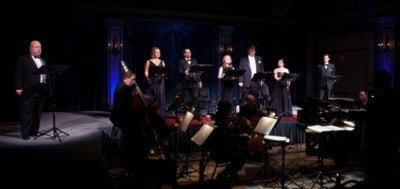“And this was not the architect’s vision . . . “ – Frank Rattenbury
Script readings. Works in progress. These terms summon images of actors gathered in a bare studio, watched by a handful of audience members, reading or singing from photocopied scripts. Expectations are, if not low, then adjusted. One is about to hear a piece that is several drafts from completion. What can one expect?
Unless your subject matter is Frank Rattenbury, legendary architect and designer of Victoria’s Empress Hotel and the B.C. Legislature. Unless your creator is celebrated local librettist and composer Tobin Stokes. And the setting is the Crystal Ballroom at the Empress Hotel. Then we’re speaking of a rather high-calibre “work-in-progress.”
On 29 and 30 September, a few fortunate guests (paying $50 each) heard selected pieces from Tobin Stokes’ new chamber opera “Rattenbury.” An extraordinary group of performers assembled: Canadian tenor Richard Margison, conductor Arthur Arnold (flown in from Amsterdam, and fresh from conducting the Moscow Symphony Orchestra), and local vocal luminaries like Ken Lavigne and Kathleen Brett. Seven local musicians ably interpreted the score.
How interesting can an opera about an architect be, though? Stokes has chosen, in Rattenbury, a fascinating subject. Rattenbury was a kind of Canadian Citizen Kane: a blazing talent, enjoying tremendous success early in his career, but plagued by poor business decisions, a troubled marriage and towering arrogance. While middle-aged, and lounging in relative obscurity, Rattenbury (‘Ratz’ to his friends) took up with a woman more than half his age. Victoria society was not impressed, and Ratz fled with his young 2nd wife to England. His life and story finished under sordid circumstances: his wife had an affair with an even younger teenaged boy who, in a fit of jealous anger, bashed in Ratz’ head with a mallet.

Stokes centres his libretto around the idea that “architecture is music frozen in time.” Rattenbury was a man that controlled his world through design (in spite of huge cost over-runs), and expected the same elegant balance in his personal and business life. Frequently, Ken Lavigne (as the young Frank Rattenbury), with his beautiful, ringing tenor, asserts his confidence. Many of the opera’s most beautiful moments come as the young Rattenbury sings, through swelling major chords, of his vision for Victoria and British Columbia, and his home life.
The piece falters somewhat in the latter half. Stokes has us identify with this conflicted and flawed man, through to middle-age (performed by Margison), and a strong narrative pulse carries us to his return to England. However, in order to set up Ratz’ murder, we must spend time with his 2nd wife and her new lover. A lovely duet follows, but it is difficult to feel anything for them, after following Ratz through so much. During some key scenes in the latter half, our title character is neither seen nor heard. It’s a narrative challenge Stokes faces, keeping the audience invested in the piece’s back-half.
In all, those 300-400 people lucky enough to be a part of this first-class workshop experience will be able to say: “I was there.” For a work-in-progress, Tobin Stokes showed us a draft of a soon-to-be Canadian opera classic. Most of the ingredients are there: now to bring “Rattenbury” from kitchen to table.
By Brent Schaus
arts@mondaymag.com
